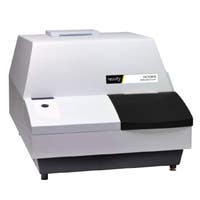Background
Individuals intolerant to ingested galactose were described as early as 1908, but it wasn’t until 1935 that elimination of galactose from the diet was shown to reverse the acute toxicity syndrome associated with galactosemia. The Leloir pathway, the main pathway of galactose metabolism, was elucidated in the early 1950s. In 1955, the accumulation of galactose-1-phosphate in red blood cells of infants with impaired galactose metabolism was demonstrated. Methods were subsequently developed to measure galactose-1-phosphate uridyl transferase (GALT) and galactose-1-phosphate in newborn blood spots.
GALT deficiency accounts for about 95% of galactosemias. Although many mutations in the GALT gene have been documented, most cases of GALT deficiency are accounted for by a few high frequency mutations. In about 5% of cases of galactosemia, the metabolic defect is in galactokinase (GALK), and very rarely, the defect is found to be in uridyl diphosphate galactose epimerase (GALE).
Clinical
GALT deficiency most often presents as a life threatening illness within the first two weeks after birth. Poor feeding, poor weight gain, vomiting and diarrhea, lethargy, and hypotonia are initial symptoms. On physical examination, infants are jaundiced with hepatomegaly, may have a full fontanelle and show prolonged bleeding after venous or arterial sampling. Cataracts are often present. Lab tests revealing liver disease, renal tubular dysfunction, and hematologic abnormalities are common. Hemolytic anemia and septicemia may occur. Long-term complications include impaired neuropsychological development and late neurologic complications. Ovarian failure due to prenatal toxic effects of galactosemia is common in females and not reversible.In GALK deficiency, the only consistent clinical finding is cataracts. In GALE deficiency, patients are, with very rare exceptions, asymptomatic, with normal growth and development.
Testing
Screening for galactosemia includes testing for elevated total galactose (galactose plus galactose-1-phosphate), and measuring GALT enzyme activity. Elevated total galactose and/or reduced GALT activity should trigger additional evaluation of the patient. The galactose level can be fractionated into free galactose and galactose-1-phosphate, and DNA analysis for the common mutations associated with GALT deficiency can be performed on the initial blood spot specimen. This combined approach quickly reveals from a single blood spot whether the galactosemia is a GALT deficiency, or is due to GALK or GALE deficiency. Confirmatory testing usually includes serum studies of galactose and the associated enzyme activity to characterize the patient’s phenotype.
Treatment
Immediate exclusion of dietary galactose (breast feeding, cow’s milk) should be instituted at the first suspicion of galactosemia. Infant soy formulas are recommended unless there is significant liver disease. For the newborn who is seriously ill at the time of diagnosis, supportive care may include treatment with vitamin K and fresh-frozen plasma to correct clotting abnormalities. Gram-negative sepsis should be assumed and appropriate IV antibiotics given.
Because the diagnosis and therapy of this disorder is complex, the pediatrician is advised to manage the patient in close collaboration with a consulting pediatric metabolic disease specialist. It is recommended that parents travel with a letter of treatment guidelines from the patient’s physician.
Inheritance
This disorder most often follows an autosomal recessive inheritance pattern. With recessive disorders affected patients usually have two copies of a disease gene (or mutation) in order to show symptoms. People with only one copy of the disease gene (called carriers) generally do not show signs or symptoms of the condition but can pass the disease gene to their children. When both parents are carriers of the disease gene for a particular disorder, there is a 25% chance with each pregnancy that they will have a child affected with the disorder.































